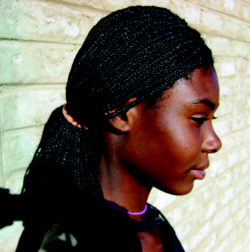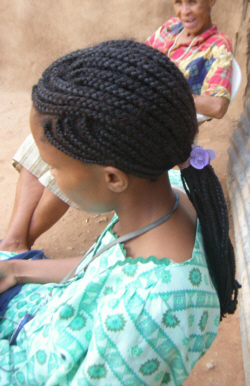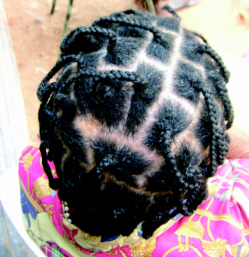Menue
Beauty in Fransfontein
(Fiona Ilonga)
Introduction
When one looks at the women of Fransfontein one will observe that, although they are from different ethnic groups, they all use similar types of decorations for their bodies. The things they use are all the same, just with different results. They are all doing this for one reason only, we have come to learn, and that is to look beautiful. Beauty in Herero is referred to as “ouua” and “îxasib/ îsasib” in Khoekhoe.
The Skin
Referred to as “omukova” in Herero and “khob” or “soros” in Khoekhoe the skin is a very sensitive part of the body. It has to be protected against the wind, the sun and the cold. Women from Fransfontein use a traditionally prepared red-stone called “!nau-i” in Khoekhoe and “otjize” in Herero for this purpose. “Otjize” can also be used by men for skin protection but this is not very common in Fransfontein.
The stone is firstly ground into soft red powder, sifted with a special cloth and then kept in a special container. Whenever it is time to apply it, this powder is then mixed with water or Vaseline to make it a nice liquid, flowing substance. It can also be mixed with commercial body creams, but mostly the women of Fransfontein mix it with a traditional fat called “komasam” in Khoekhoe and “omazeuozongombe” in Herero. This fat is made from cattle milk and smells very nice.
The red powder is very strong so one has to wash it off before going to bed, otherwise the bed linen will be destroyed (especially if white.) “!Nau” or “otjize” also makes the skin lighter in complexion and protects against spots and acne. This stone is mostly found in Opuwo. It is collected there and sold here to the locals. “Otjize” can be applied to the whole body. This is practiced by the OvaHimba people.
The Hair
It is very important to look after ones hair. Usually, with what people wash their hair depends on their social status. Soap and water is used when someone is not so well-off and shampoo and water is used by wealthy families. This is done almost three times a week. The type of moisturizer used also depends on your status: just Vaseline (petroleum-jelly) if you are from a poor family or conditioners and moisturizers if you are from a rich family. This is to prevent the hair from drying out, to keep it smooth and to also give it a shine. Some women also wear rollers in their hair, so as to comb them in different styles when ready.
Usually, the middle-aged and older women just wear head-scarves over their hair, referred to as “otjikaiva” in Herero and “!kheiba” in Khoekhoe but any woman can put on a headscarf, whether married or not. The headscarf is basically just there to protect the hair and to show that the woman is mature enough. Hair is called “ozondjize” in Herero and “/ûn” in Khoekhoe.
The Neck
The red-powder is also applied on the neck. Other things are also used
as adornments on the neck, for example traditionally made necklaces and
beads. There is a special type of wood which is used to make these
necklaces that is called “orupapa” in Herero and
“au-heib” in Khoekhoe. This wood smells very nice, and is
also believed to protect a person against evil spirits.
It is also the general belief that a woman’s neck should not be naked, thus all these decorations. If a woman has been widowed, she has to wear a black scarf around her neck, as a sign of mourning.
Dressing Beautifully
Most of the women, especially during special occasions, will wear very beautiful traditional dresses. A Nama woman, for example, wears her Nama dress, with a round-in-shape head-scarf, with beads and necklaces rounding off the picture. All women, whether Nama, Damara or Herero, usually wear shawls over their dresses around the shoulders. These shawls are called “otjikeriva” in Herero and “keliba” in Khoekhoe.
The head-scarf varies between the different ethnic groups. Scarves worn by Nama women are round in shape while the Herero scarf is usually made in the shape of the horns of a cow. The Damara head scarf is also in the shape of the Herero scarf but with the difference that it is made in such a way that the “horns” are not showing. These traditional wear are usually fitting for any special occasion, be it a wedding, a funeral or a birthday-party.
A Beautiful Smell
The most common perfume in our community is the traditional scent called “sâ-i” in Khoekhoe and “otjizumba” in Herero which is made from a mixture of different trees and smells very nice. The following local trees are used for perfume making (no English term known): Okanakauma (Herero term, Nakaume in Khoekhoe); Okarui (Herero term, !Gari-sâb in Khoekhoe); Ondao (Herero term, !Hare-i in Khoekhoe); Omueze (Herero term, #Gae-i in Khoekhoe); and Omumbara (Herero term; no Khoekhoe term).
All these trees smell very nice. They are ground into powder and sifted with a cloth. Then, the perfume powder can be applied. It can be put on clothes, on the body and in the rooms of the house. It is also believed to keep evil spirits at bay. Only a true-blue woman’s room smells “otjizumba”, the people usually say. What I mean by true-blue is that the man of a woman must know the smell of his bedroom, he must be familiar with it. A bedroom should not smell like a kitchen. It should smell nice and feminine, be attractive to the man and stir all his senses. Even when a man sleeps out somewhere he should long for the smell of his wife’s bedroom. The powder is kept in a tortoise-shell, called “!uros” in Khoekhoe.
Again, the “orupapa” is also used as a scent. It is burnt and then put under an instrument made out of sticks in the shape of a basket, which is covered with a cloth, and the fumes go in the house. This smells heavenly and the smell can last for days.
“Komasam”, the traditional-fat, is also put in a small empty Vaseline container, mixed with glue from a tree found here, and put on the body as a lotion. The glue is taken from the “sowa-heis” (Khoekhoe). The glue is called “heira-i” (Khoekhoe) and “epia” or “mumbala” in Herero. All these different perfumes must be kept safe by the woman in a place only she knows. That will keep the mystery alive.
Adding More Beauty: Accessories
There are a wide variety of accessories that the Fransfontein women
use, most of them traditional. There are necklaces made of ostrich
eggs, bracelets made of iron bangles, round plastic etc. The
“orupapa”, as mentioned before, is also used to make arm
decorations. Some necklaces are made from seeds. One makes holes in the
seeds and puts a needle with some rope through it. A necklace is called
“karab” in Khoekhoe and “oundjendje” in
otjiHerero. The necklace and bracelets usually have to complement the
outfit that is worn.
Conclusion
Our research shows how similar the different ethnic groups are when it comes to beauty. Women share similar ways to make themselves attractive. One thing, though, is that the children are forgetting the ways that our forefathers have taught us, and are now doing their own things. In the long run we might lose our identity.
When one looks at the women of Fransfontein one will observe that, although they are from different ethnic groups, they all use similar types of decorations for their bodies. The things they use are all the same, just with different results. They are all doing this for one reason only, we have come to learn, and that is to look beautiful. Beauty in Herero is referred to as “ouua” and “îxasib/ îsasib” in Khoekhoe.
| Englisch | Herero | Khoekhoe |
| Hair | Ozonjize | /Ûn |
| Skin | Omukova | !Nau-i |
| Red-stone | Otjize | Kharu |
| Traditional-fat (from milk) | Omazeuozongombe | Gomasam |
| Face | Omurungu | Eis |
| Neck | Ozengo | !Aob |
| Necklace | Oundjendje | Karab |
| Dress(ing) | Okurizara | Ana |
| Shawl | Otjikeriva | Keliba |
| Necklace out of local tree | Orupapa | Au-heib |
| Perfume | Outakoroni | !Gâi-ham xun |
| A mixture of trees making a nice smell | Otjizumba | |
| Local trees used to produce perfume | Okanakauma Okarui Ondao Omueze Orupapa Okukanga |
Nakaume !Gari-sâb !Hare-i #Gae-i Au-heib |
| Basket-like stick-instrument | Otjihanda | |
| Tortoise-shell | !Uros | |
| Edible glue from a tree | Epia omumbara | Heira-i |
The Skin
Referred to as “omukova” in Herero and “khob” or “soros” in Khoekhoe the skin is a very sensitive part of the body. It has to be protected against the wind, the sun and the cold. Women from Fransfontein use a traditionally prepared red-stone called “!nau-i” in Khoekhoe and “otjize” in Herero for this purpose. “Otjize” can also be used by men for skin protection but this is not very common in Fransfontein.
The stone is firstly ground into soft red powder, sifted with a special cloth and then kept in a special container. Whenever it is time to apply it, this powder is then mixed with water or Vaseline to make it a nice liquid, flowing substance. It can also be mixed with commercial body creams, but mostly the women of Fransfontein mix it with a traditional fat called “komasam” in Khoekhoe and “omazeuozongombe” in Herero. This fat is made from cattle milk and smells very nice.
The red powder is very strong so one has to wash it off before going to bed, otherwise the bed linen will be destroyed (especially if white.) “!Nau” or “otjize” also makes the skin lighter in complexion and protects against spots and acne. This stone is mostly found in Opuwo. It is collected there and sold here to the locals. “Otjize” can be applied to the whole body. This is practiced by the OvaHimba people.

|
| Fig 1: Hairstyle |
It is very important to look after ones hair. Usually, with what people wash their hair depends on their social status. Soap and water is used when someone is not so well-off and shampoo and water is used by wealthy families. This is done almost three times a week. The type of moisturizer used also depends on your status: just Vaseline (petroleum-jelly) if you are from a poor family or conditioners and moisturizers if you are from a rich family. This is to prevent the hair from drying out, to keep it smooth and to also give it a shine. Some women also wear rollers in their hair, so as to comb them in different styles when ready.
Usually, the middle-aged and older women just wear head-scarves over their hair, referred to as “otjikaiva” in Herero and “!kheiba” in Khoekhoe but any woman can put on a headscarf, whether married or not. The headscarf is basically just there to protect the hair and to show that the woman is mature enough. Hair is called “ozondjize” in Herero and “/ûn” in Khoekhoe.
The Neck

|
| Fig 2: Hairstyle |
It is also the general belief that a woman’s neck should not be naked, thus all these decorations. If a woman has been widowed, she has to wear a black scarf around her neck, as a sign of mourning.
Dressing Beautifully
Most of the women, especially during special occasions, will wear very beautiful traditional dresses. A Nama woman, for example, wears her Nama dress, with a round-in-shape head-scarf, with beads and necklaces rounding off the picture. All women, whether Nama, Damara or Herero, usually wear shawls over their dresses around the shoulders. These shawls are called “otjikeriva” in Herero and “keliba” in Khoekhoe.
The head-scarf varies between the different ethnic groups. Scarves worn by Nama women are round in shape while the Herero scarf is usually made in the shape of the horns of a cow. The Damara head scarf is also in the shape of the Herero scarf but with the difference that it is made in such a way that the “horns” are not showing. These traditional wear are usually fitting for any special occasion, be it a wedding, a funeral or a birthday-party.

|
| Fig 3: Hairstyle |
The most common perfume in our community is the traditional scent called “sâ-i” in Khoekhoe and “otjizumba” in Herero which is made from a mixture of different trees and smells very nice. The following local trees are used for perfume making (no English term known): Okanakauma (Herero term, Nakaume in Khoekhoe); Okarui (Herero term, !Gari-sâb in Khoekhoe); Ondao (Herero term, !Hare-i in Khoekhoe); Omueze (Herero term, #Gae-i in Khoekhoe); and Omumbara (Herero term; no Khoekhoe term).
All these trees smell very nice. They are ground into powder and sifted with a cloth. Then, the perfume powder can be applied. It can be put on clothes, on the body and in the rooms of the house. It is also believed to keep evil spirits at bay. Only a true-blue woman’s room smells “otjizumba”, the people usually say. What I mean by true-blue is that the man of a woman must know the smell of his bedroom, he must be familiar with it. A bedroom should not smell like a kitchen. It should smell nice and feminine, be attractive to the man and stir all his senses. Even when a man sleeps out somewhere he should long for the smell of his wife’s bedroom. The powder is kept in a tortoise-shell, called “!uros” in Khoekhoe.
Again, the “orupapa” is also used as a scent. It is burnt and then put under an instrument made out of sticks in the shape of a basket, which is covered with a cloth, and the fumes go in the house. This smells heavenly and the smell can last for days.
“Komasam”, the traditional-fat, is also put in a small empty Vaseline container, mixed with glue from a tree found here, and put on the body as a lotion. The glue is taken from the “sowa-heis” (Khoekhoe). The glue is called “heira-i” (Khoekhoe) and “epia” or “mumbala” in Herero. All these different perfumes must be kept safe by the woman in a place only she knows. That will keep the mystery alive.
Adding More Beauty: Accessories

|
| Fig 4: Cosmetics |
Conclusion
Our research shows how similar the different ethnic groups are when it comes to beauty. Women share similar ways to make themselves attractive. One thing, though, is that the children are forgetting the ways that our forefathers have taught us, and are now doing their own things. In the long run we might lose our identity.
Designed with Free CSS Templates